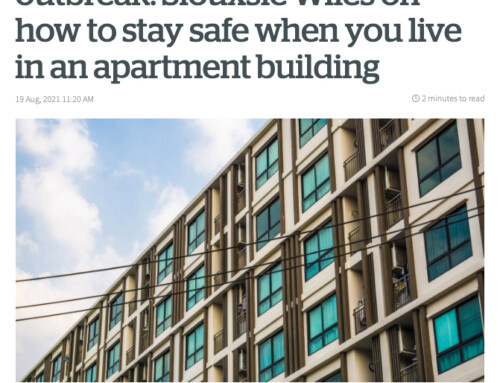
An important update from the Body Corporate Chairs Group (BCCG) regarding theHealth and Safety at Work (Asbestos) Regulations 2016 (LI 2016/15)
The new Asbestos Regulation comes into full effect on 4th April 2018. The Regulation has been made under the Health and Safety at Work Act 2015 (“HSWA”) and therefore has relevance to Bodies Corporate (“BC”) formed under the Unit Titles Act 2010. WorkSafe is the regulatory body that is responsible for HSWA and the Asbestos Regulation.
The Asbestos Regulation defines “asbestos-containing material or ACM means any material or thing that, as part of its design, contains asbestos” [Regulation (3)(1)]
The bottom line for BC:
If a BC does not have reasonable grounds to believe that asbestos or ACM is not present in its building, then it will be required to have an Asbestos Management Plan in place by 4th April 2018.
Background from WorkSafe:
Large amounts of ACM were used for a wide range of construction purposes in new and refurbished buildings until 2000. This means there are many buildings in New Zealand that contain asbestos or ACM. If the ACM is in good condition, and unlikely to be disturbed, it may not present a significant risk. However, if the ACM is in poor condition, disturbed or damaged, asbestos fibres are released into the air. If breathed in, these fibres can cause serious lung diseases, including cancers
Links to documents:
The Asbestos Regulation, HSWA, WorkSafe, information on surveys, an assessment by Bell Gully and a Report from Property Managers Group (page 8) can be found at the following links:
http://www.legislation.govt.nz/regulation/public/2016/0015/latest/DLM6729706.html
http://www.legislation.govt.nz/act/public/2015/0070/latest/DLM5976897.html
https://www.bellgully.com/publications/businesses-should-prepare-for-new-asbestos-regime
https://worksafe.govt.nz/the-toolshed/registers/asbestos-licence-holder-register/
Please refer to page 8 of the PMG Newsletter below:
http://www.propertymgr.co.nz/vdb/document/693
Key points
Application of Regulation to BC in general is certain
- It has been recognised since 2016 that BC are captured under the HSWA definition of a PCBU (Person Conducting or managing a Business or Undertaking). BCCG has conducted several courses and disseminated information to members on HSWA, BCCG Auckland (May 2016) and Wellington (August 2016).
- The Asbestos Regulation is therefore applicable to BC under the PCBU definition. There is presently no exemption on a BC size basis from the Act and therefore the Regulation will be applicable to even small BC unless the person can be confirmed by WorkSafe as an “occupier of a home to the extent that the occupier employs or engages another person solely to do residential work” [HSWA2015 S17(1)(b)(iii)].
- The Asbestos Regulation requires that “A PCBU with management or control of a workplace who knows or ought reasonably to know that there is a risk of exposure to respirable asbestos fibres in the workplace must ensure, so far as is reasonably practicable, that all asbestos or ACM giving rise to the risk at the workplace is identified” [S10(1)]
It will require some action by all BC.
- S10(1) does not apply if the PCBU has reasonable grounds to believe that asbestos or ACM is not present. Please refer to notes below.
- If asbestos or ACM is assumed to be present at a workplace [S10(1)(a)], it is taken to be identified at the workplace.
- S13(1) requires a PCBU to prepare an asbestos management plan if asbestos is identified at a workplace under Regulation 10.
- Until 4 April 2018, a PCBU with management or control of a workplace is not required to comply with regulations 13 (duty to prepare asbestos management plan) or 14 (duty to review asbestos management plan).
- If a PCBU does not have reasonable grounds to believe that asbestos or ACM is not present, then that PCBU will be required to have an Asbestos Management Plan in place by 4th April 2018.
2000 onwards
From WorkSafe and Bell Gully comments, it seems that buildings constructed from 2000 onwards are less likely to have asbestos or ACM content in their construction.
BC in this category may be able to satisfy the requirements of S10(1)(b) by obtaining from their designing architect or engineer a certification that the construction did not include any ACM and hence avoid the need for either a survey or an asbestos management plan.
If however such certification is not able to be secured, then the BC may then be required to have survey carried out. If this survey gave a negative response, then that would be grounds to satisfy S10(1)(b) and a management plan not be required.
If however the survey gave a positive response (that asbestos or ACM is present) then an asbestos management plan would be required.
PRIOR TO 2000
While many buildings constructed prior to the 1980’s are quite likely to have asbestos present, those built from the 1980’s to 2000 could also contain such materials. BC whose property was built prior to 2000 could be assumed to have the presence of asbestos unless they have an architect’s or engineer’s certification confirming the absence of such materials.
Properties in this era therefore are most likely required to have a survey completed.
Suggested courses of action for BC:
The first steps should include:
- Consulting their Body Corporate Manager and if applicable, their Building Manager, for advice as to how to proceed.
- Contacting WorkSafe with any queries that may arise from reading of the available materials for which links have been provided above.
- Establishing if an architect or design engineer certification for absence of asbestos or ACM can be obtained.
- Establish if a survey is required and to engage a suitably qualified surveyor to conduct the survey.
- Based on the survey results, either record the negative survey in the BC H&S Records, or prepare an asbestos management plan as required by the Asbestos Regulation.
Registered or Licenced Surveyors.
WorkSafe have established a register of approved asbestos contractors as noted above in the links.
PLEASE NOTE:
BCCG is providing this update as the urgency of this matter has only just become apparent – BCCG takes no responsibility for the accuracy of the content of this message which is provided to alert BC Chairs to the matter.






